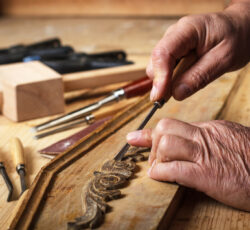 Reviving the Beauty: Exploring Furniture Restoration for Timeless Treasures
Reviving the Beauty: Exploring Furniture Restoration for Timeless Treasures
Furniture is a functional and aesthetically pleasing addition to any home. Over time, however, furniture can become worn, damaged, or outdated. Fortunately, furniture restoration can breathe new life into old pieces and bring out their true beauty once again. In this blog post, we’ll explore the basics of furniture restoration and how it can revitalize timeless treasures.
What is Furniture Restoration?
Furniture restoration is the process of repairing and refinishing old or antique furniture to restore its original beauty and functionality. This process involves a range of techniques, including stripping, sanding, repairing, and refinishing. The goal of furniture restoration is to maintain the original character of a piece while also improving its appearance and durability.
Why Restore Furniture?
There are many reasons why someone may choose to restore their furniture rather than buying new pieces. Here are just a few of the benefits of furniture restoration:
1. Cost-effective: Restoring furniture is often a more cost-effective option than buying new pieces, especially when dealing with high-quality antique furniture.
2. Sentimental value: Many people have furniture pieces that hold significant sentimental value, such as a family heirloom or a piece that has been in the family for generations. Restoring these pieces can help preserve their history and connection to the family.
3. Environmental benefits: By restoring furniture instead of buying new pieces, you can help reduce waste and prevent old furniture from ending up in landfills.
4. Quality craftsmanship: Antique and vintage furniture is often built with higher quality materials and craftsmanship than modern pieces. Restoring these pieces can help highlight these qualities and showcase their unique character.
Furniture Restoration Techniques
Furniture restoration involves a range of techniques, depending on the condition of the piece and the desired outcome. Here are some of the most common techniques used in furniture restoration:
1. Stripping: Stripping involves removing the existing finish from a piece of furniture. This is usually done with chemical strippers or sanding.
2. Sanding: Sanding involves using various grits of sandpaper to remove surface imperfections and smooth out the surface of the furniture.
3. Repairing: Repairing involves fixing any structural damage to the furniture, such as broken legs or loose joints. This can be done with wood glue, clamps, and other materials.
4. Staining: Staining involves adding color to the wood to enhance its natural beauty. This can be done with various types of wood stains, such as oil-based or water-based stains.
5. Finishing: Finishing involves adding a protective layer to the furniture to protect it from scratches and other damage. This can be done with various types of finishes, such as varnish, lacquer, or wax.
Tips for Furniture Restoration
Here are a few tips for successful furniture restoration:
1. Research: Before starting a restoration project, research the history and value of the piece to ensure that you are not devaluing it by making any irreversible changes.
2. Take your time: Furniture restoration is a labor-intensive process that requires patience and attention to detail. Take your time and don’t rush the process to ensure the best results.
3. Use the right tools: Using the right tools for each step of the process can make a big difference in the outcome. Make sure you have the necessary tools, such as sandpaper, clamps, and wood glue.
4. Safety: Furniture restoration involves working with chemicals, tools, and other potentially hazardous materials. Take appropriate safety precautions, such as wearing gloves and eye protection, to avoid injury or illness.
5. Seek Professional Help: If restoring an antique piece, it might be best to leave the restoration process to an expert. A professional furniture restorer can make superior repairs or offer advice that may not be readily available.
In Conclusion
Furniture restoration is an excellent option for those looking to give their old furniture a new lease on life. By restoring old pieces, you can save money, preserve family heirlooms, and reduce waste. Furniture restoration involves a range of techniques, including stripping, sanding, repairing, staining, and finishing. Taking your time, using the right tools, and seeking expert help can ensure successful and beautiful furniture restoration. So, the next time you come across a piece of furniture that is begging for a little love and attention, consider restoration before sending it to the curb.
